In this article,”Chlorine Lewis Dot Structure their drawing, Several Compounds And Detailed Explanations,” are described below.
The Lewis dot structure of any molecule determines the bonding between the atoms which are present in that molecule and the lone pair of electrons which are present in the same molecule. Lewis structure is also called an electron dot structure.
Chlorine atom lewis dot structure
If we know the molecular formula of the compound then we can draw the Lewis dot structure of that molecule. The nature bond and place of atoms in a molecule is determined by the Lewis dot structure of that molecule, The electronic configuration of chlorine is as follows,
Chlorine is the halogen atom which is placed in the 3rd group and 17th period in the periodic table. Therefore, its 17 electrons which are distributed are as follows
K shell – 2 electrons
L shell – 8 electrons
M shell – 7 electrons
Chlorine shows the electronic configuration are as follows
Cl 1s22s22p63s23p5 or as [Ne]3s23p5

Sodium and chlorine lewis dot structure
Likewise, above the Lewis structure of sodium and chlorine, we have to calculate the valence shell electrons from the electronic configuration of sodium and chlorine. Sodium is placed in the 1st group and chlorine is placed in the 17th group of the periodic table; therefore, sodium has one valence electron and chlorine has 7 valence electrons, together with sodium and chlorine the NaCl molecule will be formed. Sodium valence electrons = 1, chlorine valence electrons = 7
Therefore total number of valence electrons for drawing the Lewis dot structure of NaCl is 8 electrons.
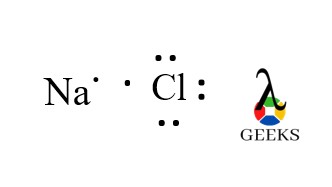
NaCl is formed by one sodium atom which is a metal and one chlorine atom which is a nonmetal NaCl an ionic compound. In the case of NaCl sodium which is metal donates the electron to chlorine and chlorine which is non-metal accepts the electrons from sodium and completes its octet. so, by completing the octet NaCl molecule is a stable Lewis structure.
Aluminum and chlorine lewis dot structure
Likewise, above Lewis’s dot structure in this Lewis structure of aluminium and chlorine, we have to calculate the valence shell electrons from the electronic configuration of aluminium and chlorine. Aluminium is placed in the 13th group and chlorine is
placed in the 17th group of the periodic table, therefore, aluminium has 3 valence electrons and chlorine has 7 valence electrons, together with aluminium and chlorine the AlCl3 molecule will be formed. Valence electrons in Aluminium = 3 valence electrons in Chlorine = 7
Thefore total number of valence electrons for drawing the Lewis dot structure of AlCl3 is 24 electrons. The electronegativity of the aluminium atom is 1.61 and that of the chlorine atom has 3.16 electronegativity due to less electronegativity of aluminium it is placed in the center of the molecule and three chlorine atoms are present around the aluminium atom.
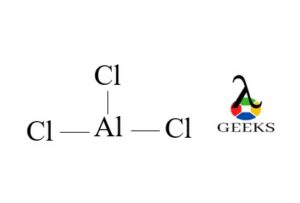
In the above structure, the aluminium atom and three chlorine atom forms a three-sigma bond, one sigma bond is formed by two valence electrons hence out of a total of 24 valence electrons 8 electrons are used in three-sigma bond formation so a total of 18 valence electrons are remaining.
The aluminium atom requires three electrons to complete its octet. hence forming a three-sigma bond with three chlorine atoms they complete their octet. And chlorine requires 7 valence electrons to complete its octet, already it shares two electrons with aluminium remaining six electrons form three lone pairs of electrons on the chlorine atom itself, and complete its octet.

Calcium chloride lewis dot structure
Lewis dot structure of calcium (Ca) and chlorine (Cl) is a unique structure because it is an ionic compound formed by a metal (Ca) and non-metal chlorine (Cl) The Lewis dot structure of CaCl2 contains a 2+ positive charge on calcium metal and one negative charge on chlorine nonmetal.
As calcium is placed in the 2nd group and chlorine is placed in the 17th group of the periodic table, calcium has two valence electrons and 7 valence electrons. Calcium valence electron = 2, Chlorine valence electron = 7
Total valence electron available for drawing the Lewis dot structure of CaCl2 are 2 + (7*2) = 16 valence electrons.
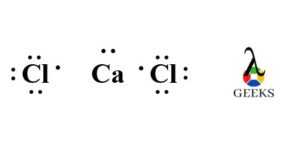
CaCl2 is the ionic compound in which the metal atom donates the electrons to the non-metal and the non-metal accepts the electrons from the metal atom. In the case of CaCl2 calcium which is metal donates one electron to one chlorine atom and the remaining one electron to another chlorine atom and chlorine which is non-metal accepts the electrons from calcium and completes its octet.

Magnesium and chlorine lewis dot structure
Lewis dot structure of Magnesium (Mg) and chlorine (Cl) is a unique structure because it is an ionic compound formed by an alkaline earth metal magnesium (Mg) and nonmetal which is halogen chlorine (Cl) The Lewis dot structure of MgCl2 contains 2+ positive charge on magnesium alkaline earth metal and one negative charge on chlorine nonmetal. As magnesium is placed in the 2nd group with a 12 atomic number and chlorine is placed in the 17th group with a 17 atomic number, of the periodic table hence magnesium has two valence electrons and chlorine has 7 valence electrons. magnesium valence electron = 2
Chlorine valence electron = 7, therefore total valence electron available for drawing the Lewis dot structure of MgCl2 are 2 + (7*2) = 16 valence electrons.

MgCl2 is the ionic compound in which the alkaline earth metal magnesium atom donates the electrons to the non-metal halogen chlorine and the non-metal accepts the electrons from the metal atom. In the case of MgCl2 magnesium which is metal donates one electron to one chlorine atom and the remaining one electron to another chlorine atom and chlorine which is non-metal accepts the electrons from magnesium and completes its octet.
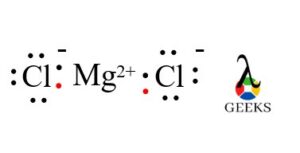
Carbon and chlorine lewis dot structure
In carbon and chlorine Lewis dot structure, the central atom is carbon which is bonded with four chlorine atoms. The carbon contains has 4 valence electrons and chlorine has 7 valence electrons in the CCl4 molecule total of 32 valence electrons are present.
Here, Carbon has 4 Valence Electrons, Chlorine has 7 Valence Electrons. There are 4 atoms of Chlorine in CCl4
So, the total number of Valence Electrons is, 7*4 = 28 Valence Electrons. Thus total, 4+28=32 valence electrons are present
In CCl4 molecule central atom is carbon which is surrounded by four chlorine atoms and form four C-Cl bonds. These four bonds use 8 valence electrons out of 32 valence electrons. Now remaining 24 valence electrons are placed around the four-chlorine atoms in the form of nonbonding electron pairs. Hence four chlorine atom has 12 lone pair .
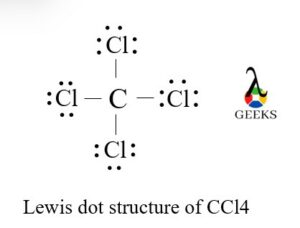
Phosphorus and chlorine lewis dot structure
Lewis’s structure of phosphorus and chlorine forms a PCl5 molecule. Phosphorus is placed in the 15th group of the periodic table with the electronic components of 2,8,5 that’s why it has 5 valence electrons present in its outermost shell.
Chlorine is placed in the 17th group of periodic tables hence it has 7 valence electrons in its outermost shell, with electronic components of 2,8,7. Each chlorine atom will form a sigma bond with the phosphorus atom for attaining its octet rule stability. Also, phosphorus gains its 5 valence electrons one to each of the chlorine atoms. The phosphorus atom has 3 valencies but due to its vacant 3d orbital, it combines with the five-chlorine atom and becomes stable.
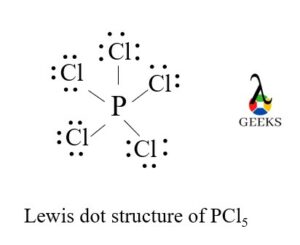
Strontium and chlorine lewis dot structure
Strontium (Sr) is a metal and chlorine (Cl) is a nonmetal form of an ionic compound called strontium chloride (SrCl2). Strontium has two valence electrons while chlorine has 7 valence electrons. In strontium chloride molecule strontium metal donates one electron to one chlorine atom and another electron to another chlorine atom also chlorine has 7 valence electrons which require one electron to complete its octet and become stable.
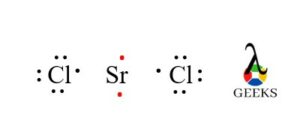
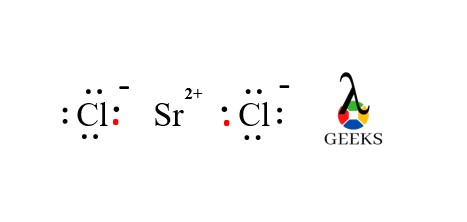
Oxygen and chlorine lewis dot structure
Oxygen is placed in the 16th group and chlorine is placed in the 17th group in the periodic table. Therefore, oxygen has six valence electrons and chlorine has seven valence electrons and in ClO molecule has one chlorine atom and one oxygen atom is present. one negative charge is placed on the ClO molecule hence a total of 14 valence electrons means 7 pairs of electrons are present in the ClO molecule. Because one pair of electrons contains two electrons. the 14 valence electrons are distributed in the ClO molecule are as follows,
Chlorine is placed in the 3rd period, therefore, more than 8 electrons are present in its last shell, and oxygen is placed in the 2nd period hence it can not keep more than 8 electrons. therefore, in the ClO molecule chlorine and oxygen form one sigma bond between them. and three lone pairs each on both chlorine and oxygen atom.

According to formal charge calculations, chlorine has zero formal charges and oxygen has a -1 formal charge. Hence in a stable Lewis structure, the oxygen atom has a -1 charge on itself.
Formal charge = Valence electrons- non bonding electrons -1/2 bonding electrons
For chlorine formal charge = 7 – 6 –1/2 (2) = 0
For oxygen atom formal charge = 6 – 6 – ½ (2) = -1

Barium and chlorine lewis dot structure
Likewise, above Lewis’s dot structure in this Lewis structure of barium and chlorine, we have to calculate the valence shell electrons from the electronic configuration of barium and chlorine.
As barium is placed in the 2nd group and chlorine is placed in the 17th group of the periodic table, Barium has two valence electrons and 7 valence electrons. Barium valence electron = 2 , Chlorine valence electron = 7
∴ Total valence electron available for drawing the Lewis dot structure of BaCl2 are 2<strong> + (7*2) = 16 valence electrons.
BaCl2 is the ionic compound in which the metal atom donates the electrons to the non-metal and the non-metal accepts the electrons from the metal atom. In the case of BaCl2 barium which is metal donates one electron to one chlorine atom and the remaining one electron to another chlorine atom and chlorine which is non-metal accepts the electrons from barium and completes its octet and form stable Lewis dot structure.


Chlorine ion lewis dot structure
If we know the molecular formula of the compound then we can draw the Lewis dot structure of that molecule. The nature bond and place of atoms in a molecule is determined by the Lewis dot structure of that molecule, The electronic configuration of chlorine is as follows,
Chlorine is the halogen atom which is placed in the 3rd group and 17th period in the periodic table. Therefore, its 17 electrons which are distributed are as follows
K shell – 2 electrons
L shell – 8 electrons
M shell – 7 electrons
Chlorine shows the electronic configuration are as follows
Cl 1s22s22p63s23p5 or as [Ne]3s23p5

Conclusion:
In the above article various lewis dot structure their drawings and detailed explanation are given . Also this article gives the presence of number of valence electrons in all the Lewis dot structure.

Hi….I am Darshana Fendarkar, I have completed my Ph.D. from the University of Nagpur. My area of specialization is Inorganic Chemistry.
I have an experience as a Chemist at Earthcare Pvt. Ltd. Also I have 2 years of experience in teaching. Currently, I am working with Lambdageek as a Subject Matter Expert.